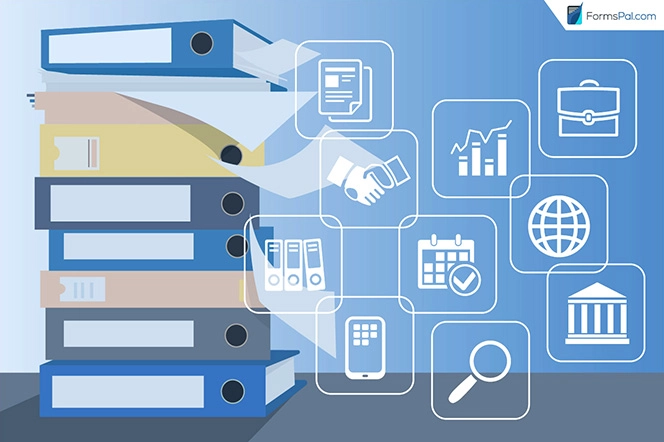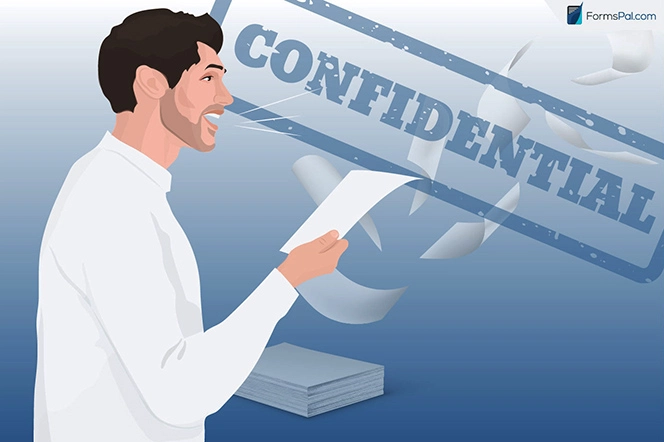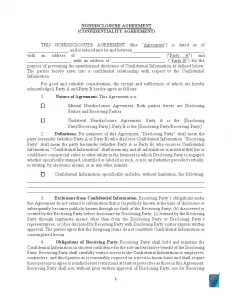Confidentiality Agreement Template
A confidentiality agreement is a document or a part of a document used by companies and individuals who want to protect their corporate information, ideas, technologies, innovations, etc. from being disclosed to unauthorized third parties. Essentially, at least one of the parties in the agreement takes the responsibility of not disclosing the information which is referred to as confidential.
The document is also referred to as a non-disclosure agreement or confidentiality disclosure agreement. The name of the document might also vary based on the industry it is used in.
The parties in the document are called the disclosing party and the receiving party (or recipient).
The agreement is usually valid for the term of employment or duration of the project and a certain period of time after that. Usually, this term is specified in an agreement. It is common to set a period from three to five years after the end of working relations, but it is completely up to the disclosing party.
In this article, we are about to tell more about a confidentiality agreement, what confidential information is, and what to take into account when creating a legally-binding document.

Build Your Document
Answer a few simple questions to make your document in minutes
Save and Print
Save progress and finish on any device, download and print anytime
Sign and Use
Your valid, lawyer-approved document is ready
- What Is the Purpose of a Confidentiality Agreement?
- Common Uses of a Confidentiality Agreement
- A Confidentiality Agreement and Relation with Similar Documents
- Are Confidentiality Agreements Considered Enforceable?
- How to Get a Confidentiality Agreement?
- How to Fill out a Confidentiality Agreement?
- 5 Things to Check to Make Sure Your Confidentiality Agreement Is Valid
- Frequently Asked Questions
What Is the Purpose of a Confidentiality Agreement?
A confidentiality agreement is aimed at the protection of information of various types:
- Intellectual property – such information involves trade secrets, patents, innovations, know-how, technologies, software, scientific information, etc.
- Customer information – it might be any information relating to clients of a company, including lists of customers, agreements, and business relationships.
- Details about product/service – it might include everything regarding production, equipment, techniques, design, distribution, etc.
- Marketing information – such information comprises any information collected from customers in order to promote products, improve services, sales, branding, etc.
- Business information – details about the employees, internal processes, operational procedures, etc.
Common Uses of a Confidentiality Agreement
A confidential clause is often included in employment agreements that a person gets familiar with before starting their work duties at a company that has confidential information and wants to protect it. Along with that, the document might be needed in the following situations:
- When a hiring company wants to keep their information secured while holding negotiations about the position with an applicant
- When several companies want to cooperate and they want to have some information discussed in a confidential mode
- When a company wants to establish working relations with an independent contractor and they want to keep their corporate information private
- When selling a business in case the seller wants to not reveal the information of the company
A confidentiality agreement is also used in many types of business relations, including:
- Interviews for management or senior positions that involve discussing a company’s confidential information and signing of the contract before the interview
- Contractual or consultant work where an agreement should be signed before the assignment and final products are discussed
- Negotiations between vendor and prospective buyer involving sharing details about products or other confidential information
- Discussions about the purchase of a stock or a company when confidential information is shared between the owner and a prospective buyer
In all these cases, a company owner benefits from creating and signing a confidentiality agreement with the other party as in this way, they are able to keep their proprietary information, trade secrets, customers, marketing, and other important information and not letting competitors make use of it.
A Confidentiality Agreement and Relation with Similar Documents
A confidentiality agreement has a lot in common with other agreements that have to do with preventing business information from being disclosed to other parties.
A confidentiality agreement and a non-disclosure agreement (NDA)
Those two documents are often used interchangeably. But an NDA might be considered a more narrow document as it attempts to protect confidential business information from being released to a third party. A confidentiality agreement has the same purpose, the only difference is connected with the circumstances when those two documents might be used.
Confidentiality agreements are usually used in situations that require a higher degree of secrecy than an NDA. The latter implies non-disclosure of private or personal information when a confidential agreement requires more proactiveness from an individual when it comes to keeping the secrecy of a company’s information. This might involve not only non-disclosure of confidential information but also putting restrictions on the use of confidential data, protection of informational databases, preventing criminal actions regarding the information, etc.
A confidentiality agreement and a non-compete agreement
A non-compete agreement focuses on prohibiting the former employee from entering into the competition with their former employer. Entering the competition in this context means using the information belonging to the previous employer at a new company or becoming an independent contractor and using the information to create a direct competition with the former employer. However, such agreements are not always enforceable as they don’t correspond to the principle of free trade.
A confidentiality agreement also does not allow a recipient to use proprietary information gained from the previous company at new workplaces. This way, the new employers are deterred from hiring individuals solely for the benefit of getting useful information from them. Generally, the agreement involves a bigger scope of actions and has a broader focus than a non-compete agreement. In addition, confidentiality agreements are always enforceable and imply certain penalties for non-compliance.
These agreements are usually used together as a part of one contract but they might also act as two separate documents.
A confidentiality agreement and an employment contract
Both documents establish relations between an employee and an employer, but they have different purposes.
A confidentiality clause usually goes as a part of an employment contract and deals with the security of confidential information. At the same time, an employment contract deals with a broader scope of relations between an employer and a prospective employee.
To have a better idea of how these documents differ, you can take a look at a confidentiality agreement template and other templates that can be found on this website.
Are Confidentiality Agreements Considered Enforceable?
Generally, confidentiality agreements are enforceable, but laws might vary from state to state. As long as an agreement follows the next requirements, it has legal force:
- There are no too broad terms in the agreement.
- There are no restricting provisions regarding the recipient about any burdens or time frames
- Information classified as confidential does not contradict the best interests of the public and is not considered public knowledge
How to Get a Confidentiality Agreement?
Choose the form

An agreement protecting confidential information might be written by a company owner themselves or with the help of an attorney. In the first case, you have to choose a good template that you can find on our website, and tailor it to your business situation. Just make sure that the form you choose is devised for usage in your specific state.
However, even then having the document checked by a lawyer would help you make sure you have defined all confidential information you want to be protected in your document.
Decide on how many parties share confidential information

A confidentiality agreement might have two forms, depending on how many parties share proprietary information according to the document.
If there is only one party sharing the information, the document is considered unilateral. It means that the receiving party will be the sole party bound to protect confidential information specified in the document.
If both parties agree to share with each other and protect confidential information, the document is referred to as mutual or bilateral. In such a case, both disclosing and receiving parties will be bound to the terms of the document and required not to disclose each other’s confidential information.
There are also multilateral confidential agreements. In such documents, there are three or more parties. It includes the provisions about information disclosure by all parties and eliminates the need to create several separate agreements. The parties have to review and execute only one agreement instead of two or three separate ones.
Define what information you want to protect

This stage of writing a confidentiality agreement requires the most attention of the disclosing party as missing out on some types of information in the agreement might lead to unfortunate legal consequences for them.
The best idea is to define clearly and unambiguously what confidential information is. Any information that is of value for the company can be considered confidential, for example, patentable data, programming code, etc. Along with the information that is considered confidential, it is also important to mention details related to it. For instance, marketing strategies, customer surveys can be considered details related to confidential information.
Specify what will happen in case of non-compliance

The receiving party should know what they will face if they violate the provisions of the agreement and accidentally or intentionally share the company’s confidential information with the third party. Most often, non-compliance leads to the recipient having to pay monetary compensation along with other financial losses to the disclosing party due to violation of the agreement.
Validate the agreement

The best validation of the agreement is having the signatures of each party notarized. It helps verify the identity of a company’s owner (or their representative) and a recipient. However, sometimes the recipient might not want to have a third party witness their signature. Then, the best idea is to check a person’s signature on their driving license. This way, it is easy to see whether the signatures match.
Share the confidential information

At this stage, the disclosing party might feel free to share confidential information with the recipient. The latter should keep in mind that once they get to learn confidential information, they should retain it and share it only with authorized individuals. Shall the specified confidential information be made publicly known, the recipient will be liable for the breach of the contract and possible losses of the disclosing party.

How to Fill out a Confidentiality Agreement?
In order to see what should be included in the document, you can use our free confidentiality agreement template. Generally, the following steps should be followed.
Step 1
Here, include the effective date of the agreement, the names of the parties – a company (employer or the disclosing party), and an individual (employee, the receiving party, or the recipient).
Step 2
It would be wise to start the document by defining the main terms of the agreement. It will help make sure both the disclosing party and the recipient are on the same page.
Write the recitals. They are supposed to generally tell about the purpose of the document. Namely, the section should tell what exact information the recipient will get to learn by entering into a working relationship with the company.
Step 3
In this section, mention the period from the effective date of the agreement during which the recipient cannot use or disclose confidential information received from the company for any purposes. Some exceptions might also be included here. For instance, you can use the following wording:
“The recipient has the right to disclose Confidential information received under this Agreement to people within the Company only in case such individuals (i) have a need to know and (ii) are bound in a written form to protect the confidentiality of such information.”
Step 4
This section of the agreement should deal with the proprietary information to which the provisions of the agreement cannot be applied. For instance, it might be information that was already described in a printed publication available to the public in any part of the world, or is generally disclosed to third parties without restrictions on the company’s part, or was not referred to as confidential information when it was disclosed by the recipient for the first time, etc.
Step 5
Here, mention that the title to confidential information that is the object of this agreement remains the sole property of the company.
The agreement might also state that should the company ask to return any tangible items that contain proprietary information, the recipient should comply.
Step 6
Further in the agreement, there should be the Terms and Conditions section. It should specify:
- The consequences of non-compliance for the recipient
- How the provisions of the agreement are affected when one of them is considered invalid or unenforceable
- Whether it is the disclosing party or the recipient who carries the burden of proof that the information is not confidential and does not constitute a trade secret
- What laws are applicable to this agreement
- Other necessary provisions regarding the liabilities of the disclosing party and the recipient
Step 7
In this part of the agreement, mention whether it can be modified and if yes, in what ways.
Step 8
The last thing to do is to put signatures and write the names of the recipient and the company’s owner (or their representative). For the latter, the title of the representative should be mentioned.
A confidentiality agreement does not require notary acknowledgment by law in order to be legally binding. But in some situations, it might be wise to notarize the agreement to validate the signatures of the parties.
Writing a confidentiality agreement requires a thorough approach as it often affects all the employees in the company. If you do not include some important information or do not define confidential information appropriately, you will not be able to make the recipient liable for disclosing it to unauthorized third parties. This is why using the very first free confidentiality agreement template found on the web is not the best idea. We offer you to use our online document builder – the tool for creating a legally binding confidentiality agreement. Not only will it allow you to get the document in less than 15 minutes, but you will also be able to easily download and print it!
5 Things to Check to Make Sure Your Confidentiality Agreement Is Valid
It is important to pay attention to every single definition and nuance in the agreement as the recipient might contest the agreement in a court if the provisions are too restrictive or vague.
Definition of “confidential information”
If the definition is too broad, a court might not enforce the document, especially if it doesn’t have a defined geographical limitation. The agreement should only include the information that is marked as confidential. As well as that, trade secrets and confidential information are different things from the perspective of law, that is why different types of information should be marked differently.
Scope
The unreasonable scope will increase the likelihood of a confidentiality agreement being struck down by a court. Too anti-competition clauses that overly restrict an employee after the termination of work relations, for example, asking the recipient to never enter the same industry again or that will last till the end of an employee’s life, will be invalidated by a court.
Publicly known information
If there is no breach or fault of the recipient and the information in the agreement becomes publicly known, it cannot be considered confidential and the recipient cannot be liable for that.
One of the cases when information cannot be considered confidential is when a company signs confidentiality agreements with 4 suppliers and fails to do it with the 5th. If the information that the 5th recipient got to know became public, the first 4 documents cannot be valid anymore.
Information specific to the industry
When the recipient has developed the information independently due to being in the same line of work with the disclosing party, the latter cannot accuse the recipient of non-compliance as they could have made their own discoveries before the collaboration.
Signing the document
If a document was signed by a non-authorized person, for example, a company’s representative who didn’t have the authority to execute contracts, a confidential agreement might be invalidated. Or if a contract is multilateral and each of the partners is the recipient, obtaining the signature of only one partner might lead to the same legal consequence.
There is no standardized period for such agreements, and it is completely up to the party that created the agreement. But generally, such contracts last for two-five years. The parties should also take into account that the document terminates if confidential information which is the object of the agreement becomes available to the public. Yes, it is important that employees sign the document if you as an employer want to protect confidential information concerning customers, processes, accounting, strategies, intellectual property in your company. However, not all employees have to sign the agreement. Many positions do not imply dealing with confidential information, which is why not all employees are required to sign the document. It is up to a candidate whether to sign the statement or not. However, an employer in such a case can use their right to withdraw the applicant from consideration for the work position. No, even if you have already hired an individual, signing the statement to protect your proprietary information is still relevant. However, it is always better to make an applicant sign the agreement at the beginning of the hiring process. In most situations, a confidentiality agreement template would be enough to cover all the protections of the proprietary information. However, it is always a good idea to check the agreement template with the help of legal counsel to be sure it is compliant with the state laws and legislation regarding the protection of confidential information. Exclusions to confidential information in a confidentiality agreement might be: In some cases, a company owner might face the fact that the absence of a confidentiality agreement works out better than having their employees to sign it. For instance, let’s say there is a business dealing with cell phone repairs. An owner of the company decides to implement a confidentiality agreement five years from starting the business and make all the currently working employees sign it. Such a confidentiality agreement has a non-compete clause. If employees refuse to sign it, they have to leave. At the same time, some of the key employees have been handling their own same businesses for several years and getting a good profit from it. But a new agreement prohibits them from any sort of competitive behavior. As a result, such employees would prefer to keep running their own businesses, and the company would lose some of the most valuable workers.Frequently Asked Questions
How long does a confidentiality agreement last?
Should employees sign a confidentiality agreement?
What if an applicant does not want to sign a confidentiality agreement?
If I have already hired an employee, is it too late to sign the agreement?
What is better: using a confidentiality agreement template or a document written from scratch?
What information is not considered confidential?
Are there any drawbacks to signing a confidentiality agreement for an employer?
To get a better idea of how a confidentiality agreement looks like, use our free agreement template!
